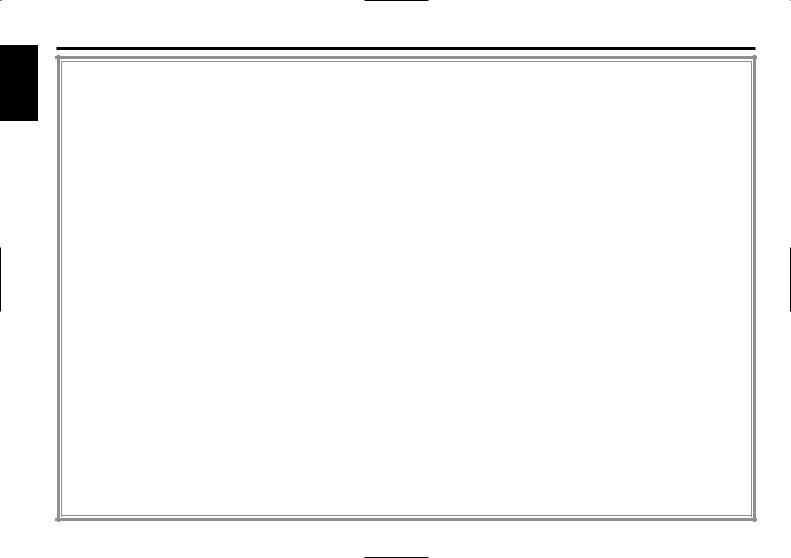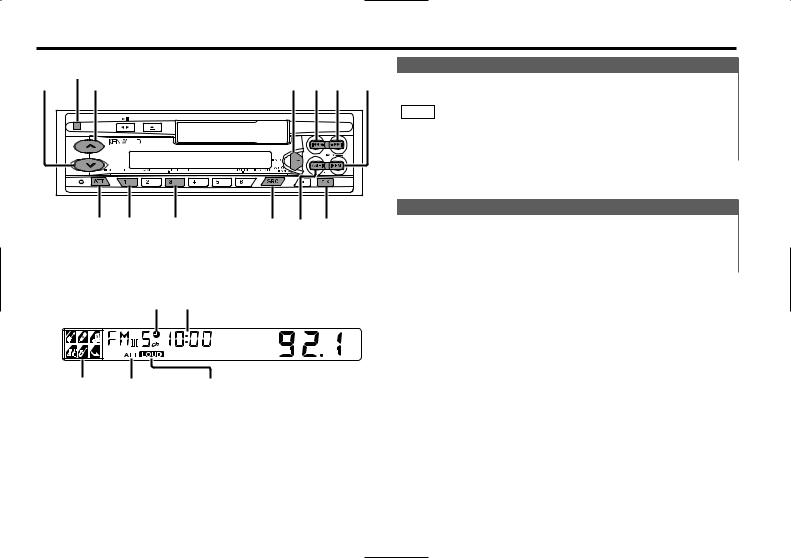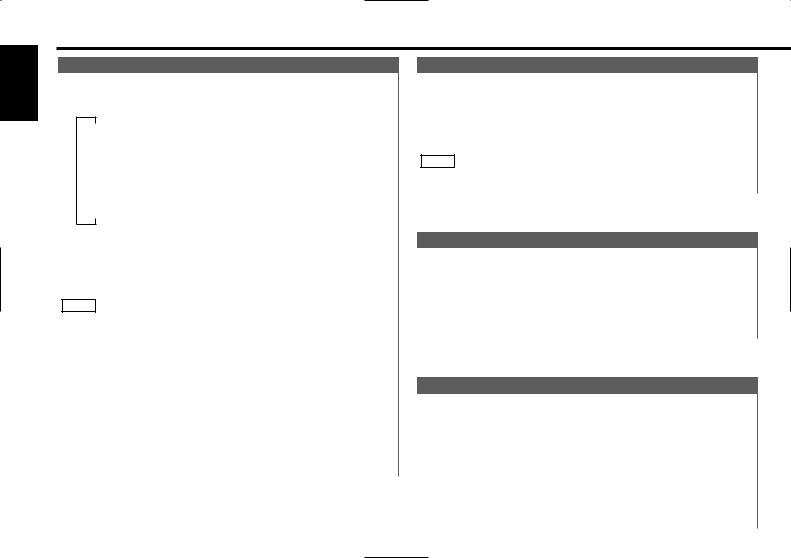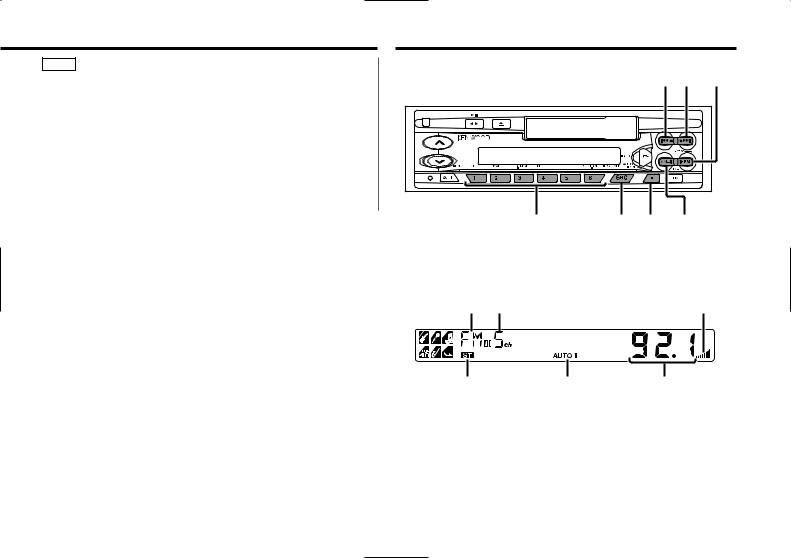Kenwood KRC-309S, KRC-409 User Manual

KRC-409 KRC-309S
CASSETTE RECEIVER
INSTRUCTION MANUAL
AMPLI-TUNER-LECTEUR DE CASSETTE
MODE D’EMPLOI
RADIO CASETE
MANUAL DE INSTRUCCIONES
RADIO CASSETE
MANUAL DE INSTRUÇÕES
Take the time to read through this instruction manual.
Familiarity with installation and operation procedures will help you obtain the best performance from your new cassette-receiver.
For your records
Record the serial number, found on the back of the unit, in the spaces designated on the warranty card, and in the space provided below. Refer to the model and serial numbers whenever you call upon your KENWOOD dealer for information or service on the product. Model KRC-409/309S Serial number
© B64-1826-00 (KW)

English
Contents
Safety precautions................................................ |
3 |
General features |
|
Power............................................................................................ |
5 |
Volume .......................................................................................... |
5 |
Switching Modes .......................................................................... |
6 |
Attenuator ..................................................................................... |
6 |
Loudness ...................................................................................... |
6 |
System Q ...................................................................................... |
6 |
Audio Control Setting.................................................................... |
7 |
Mobile Preset................................................................................ |
8 |
Clock display ................................................................................. |
8 |
Adjusting Time .............................................................................. |
8 |
Disabled System Indicator (DSI) ................................................... |
8 |
Theft Deterrent Faceplate............................................................. |
8 |
Tuner features |
|
Tuning ......................................................................................... |
10 |
Station Preset Memory............................................................... |
10 |
Auto Memory Entry .................................................................... |
10 |
Clean Reception System Circuit (CRSC)..................................... |
11 |
Cassette player features |
|
Playing Cassette Tapes............................................................... |
12 |
Fast Forwarding and Rewinding Cassette Tapes ....................... |
12 |
Using Dolby B Noise Reduction.................................................. |
12 |
Switching Tape Types................................................................. |
12 |
Blank Skip ................................................................................... |
12 |
Tape Advance ............................................................................. |
13 |
Music Repeat.............................................................................. |
13 |
External disc control features |
|
Installation |
|
Accessories................................................................................. |
17 |
Installation Procedure ................................................................. |
17 |
Connecting Wires to Terminals .................................................. |
18 |
Installation ................................................................................... |
19 |
Troubleshooting Guide ....................................... |
22 |
Specifications ..................................................... |
26 |
Playing Disc mode ...................................................................... |
14 |
Fast Forwarding and Reversing Disc Play .................................. |
14 |
Track Search ............................................................................... |
14 |
Disc Search ................................................................................. |
14 |
Track / Disc Repeat..................................................................... |
15 |
Track Scan................................................................................... |
15 |
Random Play ............................................................................... |
15 |
Magazine Random Play............................................................... |
16 |
— 2 —

Safety precautions
2WARNING |
2CAUTION |
To prevent injury or fire, take the following precautions:
•Insert the unit all the way in until it is fully locked in place. Otherwise it may fall out of place when jolted.
•When extending the ignition, battery, or ground wires, make sure to use automotivegrade wires or other wires with a 0.75mm2 (AWG18) or more to prevent wire deterioration and damage to the wire coating.
•To prevent a short circuit, never put or leave any metallic objects (such as coins or metal tools) inside the unit.
•If the unit starts to emit smoke or strange smells, turn off the power immediately and consult your Kenwood dealer.
•Make sure not to get your fingers caught between the faceplate and the unit.
•Be careful not to drop the unit or subject it to strong shock.
The unit may break or crack because it contains glass parts.
•Do not touch the liquid crystal fluid if the LCD is damaged or broken due to shock. The liquid crystal fluid may be dangerous to your health or even fatal.
If the liquid crystal fluid from the LCD contacts your body or clothing, wash it off with soap immediately.
To prevent damage to the machine, take the following precautions:
•Make sure to ground the unit to a negative 12V DC power supply.
•Do not open the top or bottom covers of the unit.
•Do not install the unit in a spot exposed to direct sunlight or excessive heat or humidity. Also avoid places with too much dust or the possibility of water splashing.
•Do not set the removed faceplate or the faceplate case in areas exposed to direct sunlight, excessive heat or humidity. Also avoid places with too much dust or the possibility of water splashing.
•To prevent deterioration, do not touch the terminals of the unit or faceplate with your fingers.
•Do not subject the faceplate to excessive shock, as it is a piece of precision equipment.
•When replacing a fuse, only use a new one with the prescribed rating. Using a fuse with the wrong rating may cause your unit to malfunction.
•To prevent a short circuit when replacing a fuse, first disconnect the wiring harness.
•Do not place any object between the faceplate and the unit.
•Do not use your own screws. Use only the screws provided. If you use the wrong screws, you could damage the unit.
IMPORTANT INFORMATION About the disc changer to be connected:
To connect a disc changer having the "O-N" switch to this unit, set the "O-N" switch to "N".
To connect a disc changer having no "O-N" switch to this unit, the converter cord CADS100 and/or switching adapter KCA-S210A are required as options.
If a model with no "O-N" switch is connected, some unavailable functions and information that cannot be displayed are generated, such as the DNPS, DNPP, Magazine random play, and CD Text display. Note that none of the KDC-C100, KDC-C302, C205, C705, and non-Kenwood CD changers can be connected.
2CAUTION
You can damage both your unit and the CD changer if you connect them incorrectly.
Manufactured under license from Dolby Laboratories.
“Dolby” and the double-D symbol are trademarks of Dolby Laboratories.
— 3 —

English
Safety precautions
NOTE
•If you experience problems during installation, consult your Kenwood dealer.
•If the unit does not seem to be working right, try pressing the reset button first. If that does not solve the problem, consult your Kenwood dealer.
Reset button
•Characters in the LCD may become difficult to read in temperatures below 41 ˚F (5 ˚C).
•The illustrations of the display and the panel appearing in this manual are examples used to explain more clearly how the controls are used. Therefore, what appears on the display in the illustrations may differ from what appears on the display on the actual equipment, and some of the illustrations on the display may represent something impossible in actual operation.
•The functions that can be used and the information that can be displayed will differ depending on the external disc players being connected.
Cleaning the Faceplate Terminals
If the terminals on the unit or faceplate get dirty, wipe them with a dry, soft cloth.
Cleaning the Unit
If the faceplate of this unit is stained, wipe it with a dry soft cloth such as a silicon cloth. If the faceplate is stained badly, wipe the stain off with a cloth moistened with neutral cleaner, then wipe neutral detergent off.
2CAUTION
Applying spray cleaner directly to the unit may affect its mechanical parts. Wiping the faceplate with a hard cloth or using a volatile liquid such as thinner or alcohol may scratch the surface or erases characters.
FCC WARNING
This equipment may generate or use radio frequency energy. Changes or modifications to this equipment may cause harmful interference unless the modifications are expressly approved in the instruction manual.
The user could lose the authority to operate this equipment if an unauthorized change or modification is made.
Cleaning the Tape Head
After you have listened to many cassettes over a long period of time, magnetic powder from the tapes and dust accumulates on the tape head, causing noise and a deterioration in sound quality. Clean the tape head using a cleaning tape or cleaning kit designed for use in car audio systems.
Handling Cassette Tapes
•Do not play a cassette whose tape has gone slack. In such a case, wind it tight using a pencil or the like in one of the spools. Playing slack cassette tapes can result in the tape tangling around the capstan and/or pinch rollers, causing trouble.
•Do not play a deformed cassette or one whose label is starting to come off, as it can cause the unit to malfunction.
•Do not leave tapes in hot places, such as on dashboards and other spots exposed to direct sunlight, or near heater outlets. They can deform the cassette.
•Avoid using extremely long cassette tapes, such as 100-minute-long tapes. Such tapes are very thin, and can tangle easily around the pinch rollers or other parts inside the unit, causing unit failure.
•Remove a cassette tape from the unit when not listening to it for a while. If you leave a tape in the unit too long, it may stick to the tape head and cause unit malfunction.
— 4 —

General features
|
Release button |
|
Power |
|
|
|
|
d |
u |
Q/AUD 4 ¢ FM |
Turning on the power: |
|
|
|
Press the SRC (source) button. |
|
|
|
NOTE |
|
|
|
Turn the power on before carrying out the following procedures. |
|
|
|
Turning off the power: |
|
|
|
Press the PWR OFF button for at least one second. |
|
|
|
Volume |
ATT / LOUD #1 |
#3 |
SRC / AM CLK/ADJ |
|
|
PWR OFF |
Increasing Volume:
Press the u button to turn up the volume.
Decreasing Volume:
Press the d button to turn down the volume.
Clock indicator |
Clock display |
SYSTEM Q ATT indicator |
LOUD indicator |
indicator |
|
— 5 —

English
General features
Switching Modes
Switching Modes:
Each time you press the SRC (source) button, the mode switches as follows:
▼
Tuner mode
▼
Tape mode
▼
External disc control mode 1
▼
External disc control mode 2 / AUX mode
▼
Standby mode
Selecting standby mode:
Press the SRC button repeatedly and switch to "OFF" . When "OFF" is displayed, the standby mode is activated. The standby mode turns all functions off while leaving the power to the unit on. Use this mode when you want to have the display illuminated but don't want to listen to anything.
NOTE
•The mode switches to the next mode from any mode which cannot be used.
•The external disc control mode will differ depending on the unit that is connected.
•To enable the selection of External disc control mode 2/AUX mode, you should connect optional switching adapter KCAS210A (which allows you to select both External disc control mode 2 and AUX mode) or CD changer (KDC-CPS87, KDCCX87, KDC-CPS85, KDC-CX85, KDC-CPS82 or KDC-CX82) or switching adapter CA-C1AX (which allows you to select AUX mode only).
During the AUX mode, "AVin" will show in the display. When the CA-C1AX is being used, the AUX Mode will replace the External Disc Control Mode.
Attenuator
This function allows you to turn down the volume quickly.
Turning Attenuator On/Off:
Press the ATT button to switch the attenuator on and off. When the attenuator is on, the ATT indicator blinks.
When the attenuator is off, the volume returns to the original level.
NOTE
Turning the volume up, or turning it all the way down deactivates the attenuator function.
Loudness
This function amplifies low and high tones when the volume is turned down.
The LOUD indicator lights up when the loudness function is on.
Turning Loudness On/Off:
Press the LOUD button for at least one second to switch the loudness on and off.
System Q
You can recall the best audio setting preset for different types of the music.
Switching the Preset Sound Setting:
Each time you press the Q button, the preset sound setting switches as follows:
— 6 —

|
|
|
|
|
|
|
Scan of Flat – Easy ("SCAn") |
||
Flat ("SQ-1") |
||||
Easy ("SQ-6") |
||||
|
|
|||
Rock ("SQ-2") |
Jazz ("SQ-5") |
|||
|
|
|||
Top 40 ("SQ-3") |
Pops ("SQ-4") |
|||
As you proceed, each indicator would go on.
NOTE
The System Q function changes the values of the following sound quality parameters:
Bass center frequency, bass level, bass quality factor, bass extend, middle center frequency, middle level, middle quality factor, treble center frequency, and treble level.
Note that some of these parameters cannot be controlled by the audio control setting feature.
Their setting values are different depending on the setting of the mobile preset plan mode.
Audio Control Setting
Adjust various parameters of sound quality.
1Press the AUD button for at least one second to enter the control mode.
2Selecting mode
Press either the FM or AM button.
Each time the button is pressed, the adjustment mode will change as follows:
Pressing the FM button advances the display, and pressing the AM button reverses it.
Bass |
Fader |
Middle |
Balance |
Treble |
|
NOTE Source tone memory
Each source (tape, CD, MD, FM, AM and disc changer) has its own memory in which to store the bass, middle, and treble tone settings.
The settings made for a particular source are recalled automatically whenever you use that source (for example, FM mode uses the tone settings made for FM, AM for AM, etc.).
3Adjust each mode
Press the 4/¢ button.
Look at the table to adjust the mode being displayed.
Adjustment |
Operation of Audio control button |
|
mode |
|
|
(Display) |
4 button |
¢ button |
Bass ("BAS") |
Bass decreased. |
Bass increased. |
|
|
|
Middle("MID") |
Middle decreased. |
Middle increased. |
|
|
|
Treble("TRE") |
Treble decreased. |
Treble increased. |
|
|
|
Balance("BL") |
Left channel emphasized. |
Right channel emphasized. |
|
|
|
Fader ("FD") |
Rear channel increased. |
Front channel increased. |
|
|
|
4 Press the AUD to end the control mode.
NOTE
Determining the parameters in the audio control setting would clear all the adjustments made in the System Q and they are replaced with the values in the audio control setting.
— 7 —

English
General features
Mobile Preset
This function allows you to adjust the setting that is recalled with the System Q, according to types of speakers.
1Press the SRC button repeatedly to select the standby mode. "OFF" is displayed when the standby mode is selected.
2Press the Q button to enter the mobile preset plan mode.
3Press either the 4 or ¢ button to select the type of speaker. The setting switches as follows.
Off ("SP-F") / For the OEM speaker ("SP-O") / For 6/6x9 in. speaker ("SP-6") / For 5/4 in. speaker ("SP-5")
4Press the Q button to end the mobile preset plan mode.
NOTE
When you change the setting of type of speaker, the bass, middle, and treble tone settings are returned to original levels.
Clock display
Changing the Clock Display:
Press the CLK button to switch the clock display on and off.
NOTE
The clock indicator lights while the clock is displayed.
button to make the hours go back.
•Adjusting the minutes
Press the ¢ button to advance the minutes, or press the 4 button to make the minutes go back.
4 Press the CLK button to end the clock adjustment mode.
Disabled System Indicator (DSI)
A red indicator will blink on the unit after the faceplate is removed, warning potential thieves. The factory default for this function is ON.
Turning Disabled System Indicator On/Off:
1Turn the power of the unit off.
2While pressing buttons #1 and #3 at the same time, press the SRC button.
Repeat steps 1 and 2 above to turn DSI back on.
Theft Deterrent Faceplate
The faceplate of the unit can be detached and taken with you, helping to deter theft.
Adjusting Time
Adjust the time.
1When the clock is not displayed, first press the CLK button to display the clock.
2Press the ADJ button for at least two seconds to enter the clock adjustment mode. The clock display will blink.
3• Adjusting the hours
Press the FM button to advance the hours, or press the AM




 Projections Release button
Projections Release button 
Grooves
Removing the Faceplate:
Press the release button.
The faceplate is unlocked, allowing you to detach it.
— 8 —

NOTE
•The faceplate is a precision piece of equipment and can be damaged by shocks or jolts. For that reason, keep the faceplate in its special storage case while detached.
•Do not expose the faceplate or its storage case to direct sunlight or excessive heat or humidity. Also avoid places with too much dust or the possibility of water splashing.
Reattaching the Faceplate:
1Align the projections on the unit with the grooves on the faceplate.
2Push the faceplate in until it clicks.
The faceplate is locked in place, allowing you to use the unit.
Tuner features
4 ¢ FM/CRSC
#1 – 6 |
SRC AUTO |
AM |
|
/AME |
|
Band display Preset station number |
CRSC indicator |
ST indicator |
AUTO indicator |
Frequency |
— 9 —
